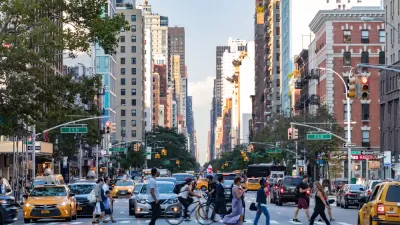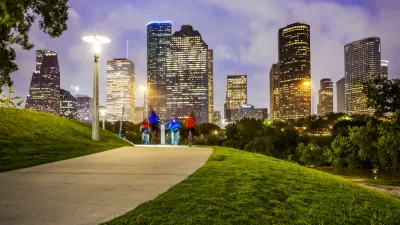Walkable urban places are poised to "put a foundation under the economy as well as government tax revenues," concludes Christopher Leinberger in a new report. Better! Cities & Towns delivers some highlights from his much anticipated study.
Last week, we previewed the results of a new study examining the emergence of Washington D.C. as a national model for walkable urbanism. Now published, the findings of the study are astounding.
"In the first regional, comprehensive study of mixed-use urban centers, Christopher Leinberger coins a clever term, WalkUPs (walkable, urban places)," writes Robert Steuteville. "Leinberger examines 43 WalkUPs in the Washington, DC, region, most of which have been created in the last two decades."
"Although they only occupy 1-2 percent of the DC land area, they account for 29 percent of the income-producing property and they generate tax revenues far out of proportion to the land they consume. Since 1990, WalkUPs have steadily gained a larger share of commercial development in the region, and Leinberger, research professor of urban real estate at the George Washington University School of Business, argues DC is a model for how the nation will develop in the coming decades."
Thanks to Rob Steuteville
FULL STORY: Study: Shift to walkable urban places is good news for economy

Study: Maui’s Plan to Convert Vacation Rentals to Long-Term Housing Could Cause Nearly $1 Billion Economic Loss
The plan would reduce visitor accommodation by 25,% resulting in 1,900 jobs lost.

Alabama: Trump Terminates Settlements for Black Communities Harmed By Raw Sewage
Trump deemed the landmark civil rights agreement “illegal DEI and environmental justice policy.”

Why Should We Subsidize Public Transportation?
Many public transit agencies face financial stress due to rising costs, declining fare revenue, and declining subsidies. Transit advocates must provide a strong business case for increasing public transit funding.

Paris Bike Boom Leads to Steep Drop in Air Pollution
The French city’s air quality has improved dramatically in the past 20 years, coinciding with a growth in cycling.

Why Housing Costs More to Build in California Than in Texas
Hard costs like labor and materials combined with ‘soft’ costs such as permitting make building in the San Francisco Bay Area almost three times as costly as in Texas cities.

San Diego County Sees a Rise in Urban Coyotes
San Diego County experiences a rise in urban coyotes, as sightings become prevalent throughout its urban neighbourhoods and surrounding areas.
Urban Design for Planners 1: Software Tools
This six-course series explores essential urban design concepts using open source software and equips planners with the tools they need to participate fully in the urban design process.
Planning for Universal Design
Learn the tools for implementing Universal Design in planning regulations.
Smith Gee Studio
Alamo Area Metropolitan Planning Organization
City of Santa Clarita
Institute for Housing and Urban Development Studies (IHS)
City of Grandview
Harvard GSD Executive Education
Toledo-Lucas County Plan Commissions
Salt Lake City
NYU Wagner Graduate School of Public Service





























